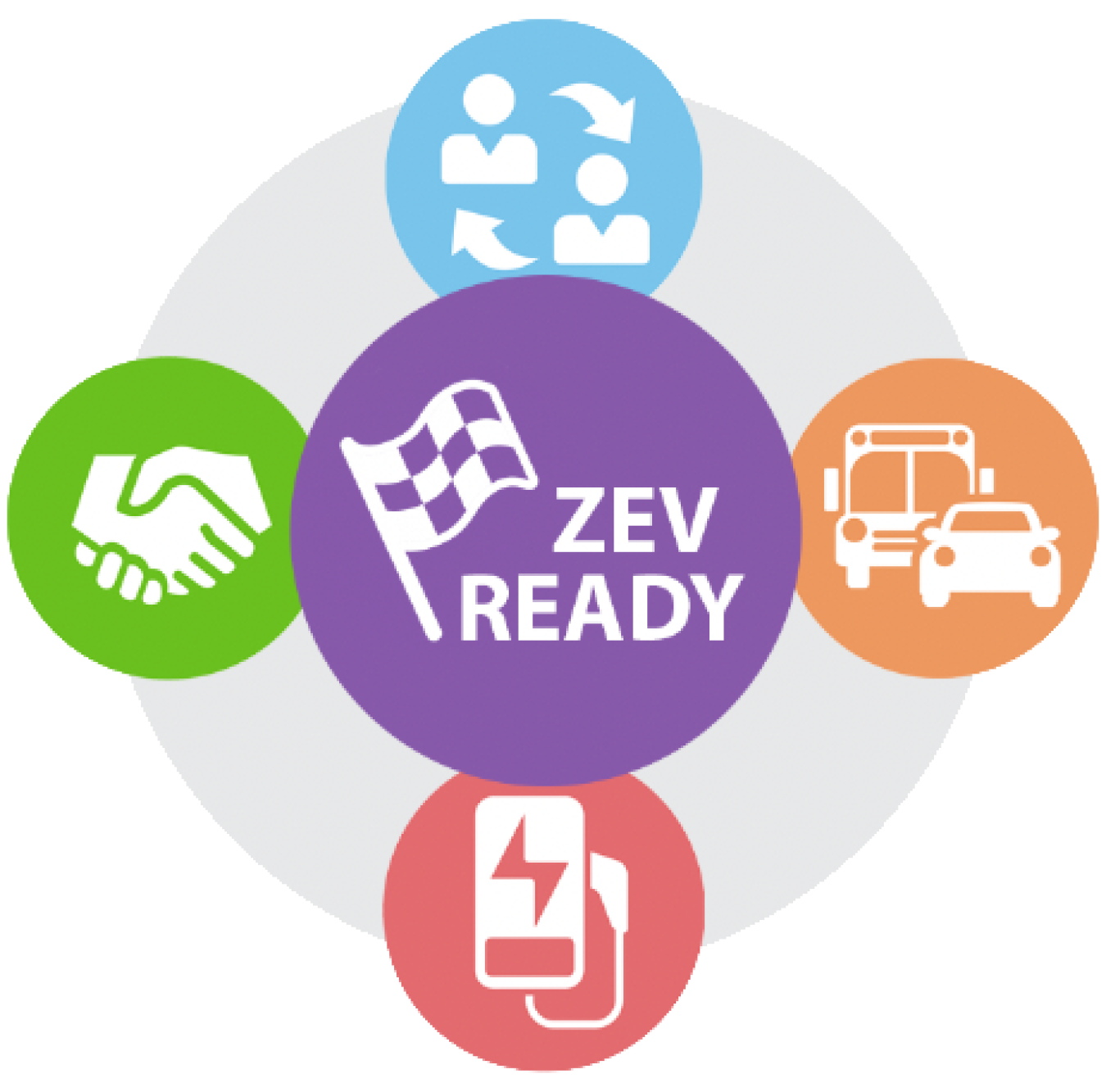The Federal Energy Management Program's (FEMP's) Federal Fleet ZEV Ready Center supports agency-level fleet electrification across individual fleet locations.
Summary of the Site-Level Electrification Process
The ZEV Ready Center is organized around the site-level federal fleet electrification process (shown below), which is comprised of three phases—plan, design, and ZEV active—and 15 process steps. The sections that follow provide an overview of the ZEV Ready Center, including:
- The high-level questions that fleet managers should evaluate in overall fleet electrification planning
- How the site-level electrification process translates this framework into recommended actions to guide stakeholders through electrification at each fleet location
- How these actions integrate with the ZEV Ready designation.
Planning Phase |
||
|---|---|---|
| Goals | Steps | ZEV Readiness |
|
Create and Train Team |
|
|
|
Overall Fleet Planning and Strategy |
|
|
|
Identify ZEV and EVSE Opportunities |
|
|
|
Financial Planning |
Step 7. Coordinate site financial planning with headquarters |
|
Design Phase |
||
| Goals | Steps | ZEV Readiness |
|
Engage with Priority Staff and Utility |
Step 8. Engage with key electrification stakeholders at site |
|
|
Design EVSE |
|
|
|
Obtain Commitment |
|
|
ZEV Active Phase |
||
| Goals | Steps | ZEV Readiness |
|
Acquire ZEVs and Install EVSE |
|
|
|
Support Operations |
|
|
Goals of the ZEV Ready Center
The purposes of the ZEV Ready Center are to:
- Guide federal fleet personnel through the process of electrifying their fleets
- Support designating agency fleet site locations as ZEV Ready, ensuring each fleet electrification stakeholder completes the recommended process steps to electrify their fleets.
The ZEV Ready Center helps federal fleet electrification stakeholders:
- Understand their roles and responsibilities for fleet electrification
- Identify opportunities to acquire the right zero-emission vehicles (ZEVs) that meet transportation mission needs
- Plan for the acquisition and installation of electric vehicle supply equipment (EVSE) to support those ZEVs
- Transform fleet operations and culture to support drivers using and charging ZEVs.
Overview of Federal Fleet Electrification
Federal fleet electrification starts with agency leadership assessing how fleet electrification efforts fit into their overall fleet plans, evaluating opportunities to acquire and deploy ZEVs and EVSE at each fleet location, and how the agency supports ZEV operations. To guide agency fleets through the process to electrify each fleet location, FEMP has developed the ZEV Ready designation that translates the electrification process into a series of recommended actions to be completed by each stakeholder at the site level.
Agency headquarters fleet managers should consider organizing overall fleet electrification planning around the proven framework discussed below. While much of the ZEV Ready Center focuses on supporting fleet electrification at the site location, it is important for all key stakeholders to understand how electrification efforts at their site fits into overall agency-level fleet electrification planning.
The fleet electrification planning framework can help answer the following questions:
- How do battery electric vehicles (BEVs) and plug-in hybrid electric vehicles (PHEVs) fit in my overall fleet plan?
- What are my candidate ZEVs, optimal locations for deployment, and EVSE needs?
- How do I prioritize facilities and infrastructure needs?
- How do I acquire the right ZEVs and EVSE?
- How do I install EVSE and leverage them for workplace charging?
- How do I support ZEV and EVSE operation, maintenance, and data collection?
To support implementation of overall agency-level fleet electrification planning across individual site locations, FEMP has established the site-level federal fleet electrification process. This process is divided into three phases—plan, design, and ZEV active—and 15 steps, each with a distinct approach for key stakeholders.
Effective collaboration and coordination between the key electrification stakeholders at the agency headquarters and at each fleet location is crucial for implementing the overall agency-level fleet electrification process.
The ZEV Ready Center guides each federal fleet electrification stakeholder, at headquarters and at each fleet location, to understand and implement these 15 recommended steps, and provides the information and tools needed to implement fleet electrification effectively.

FEMP has created the ZEV Ready designation to guide and support agency federal fleet stakeholders through the process to electrify each fleet location. It translates the federal fleet electrification planning process into a series of recommended actions. As stakeholders complete each set of recommended actions, the site location demonstrates completion of the fleet electrification process steps, and the site moves toward designation as ZEV Ready.
Electrification Planning Process Phases
At the fleet site location level, the suggested electrification planning process can be divided into three phases—plan, design, and ZEV active. These phases (and corresponding ZEV Ready process steps) are explained in more detail below.
Step 1: Identify and Coordinate Team
The critical first step in the fleet electrification process is to assemble the team of both headquarters and fleet location stakeholders to support the agency’s electrification goals.
Step 2: Review Training Materials
The second step is to ensure the key stakeholders complete the ZEV and EVSE training specific to their roles and responsibilities.
Step 3: Review Requirements, Goals, and Data
The next two steps in the fleet electrification process involve incorporating ZEVs and EVSE within the overall agency’s fleet sustainability strategy. This step consists of (1) reviewing the federal fleet sustainability requirements to understand how ZEVs assist in meeting or exceeding those fleet requirements, and (2) reporting ZEVs and EVSE data to determine compliance and evaluate fleet electrification progress.
Step 4: Align Headquarters Strategy with Site Planning
Each agency must develop an overall Zero-Emission Fleet Strategic Plan, which outlines how fleet electrification fits into the agency's overall fleet plan and sustainability strategy, while ensuring the agency complies with all federal fleet sustainability requirements.
Step 5: Identify ZEV Opportunities
Using the overall fleet strategy, fleets next should focus on identifying the specific opportunities (over a five-year time horizon) to transition vehicles at each fleet location to ZEVs. This includes assessing the suitability of electrification for each vehicle.
Step 6: Identify EVSE Opportunities
After identifying ZEV opportunities, the fleet then determines the feasibility of installing EVSE to support those candidate ZEVs at each fleet location.
Step 7: Financial Planning
After identifying—for each fleet location—potential future ZEVs acquisitions and plans for deployment of EVSE to support those vehicles, the next step is to refine and prioritize those plans based on available funding sources. This alignment of financial planning with fleet planning should include both the availability of funding to cover incremental costs for ZEVs and the acquisition, installation, and operating costs for EVSE, offset by savings from lower ZEV operating costs, other funding sources, or other secondary electrification cost savings.
Step 8: Engage with Key Electrification Stakeholders at Site
After identifying electrification opportunities at the site location and securing funding commitments, the fleet should engage the key fleet electrification stakeholders at the fleet site location to ensure effective communication and collaboration in the design and deployment of EVSE.
Step 9: Coordinate with Local Utility Service
Agencies are recommended to coordinate with local utilities early in the process to ensure effective integration of EVSE with utility service at the site and to identity opportunities to use support programs offered by utilities.
Step 10: Complete Site Assessment and Design EVSE
The next step in the fleet electrification process requires identifying the EVSE needs at the fleet location, including evaluating how many and what type of charging stations are to be acquired. Next, site fleet and facility staff should complete a siting analysis (e.g., EVSE Site Assessment) to help choose the charging station locations, guide site designs, and evaluate power requirements. This includes considering advanced charging options, such as managed charging and bidirectional charging, to support site load management. After completing a preliminary EVSE design, the site should develop an EVSE cost estimate, estimate installation timeframes, and refine and prioritize the EVSE design based on available funding sources.
Step 11: Identify EVSE at Non-Agency Locations
Fleets may also need to determine alternatives for charging ZEVs at non-fleet locations, such as home-to-work uses and other non-agency garage locations, and when they require use of public charging stations.
Step 12: Work with Leadership to Secure EVSE Funding
After completing the design of EVSE, the site fleet location should re-engage with agency leadership at the headquarters level to ensure the alignment of site fleet electrification plans with overall fleet planning and financial resources. Fleet locations may need to revise ZEV acquisition and/or EVSE design and deployment plans based on agency leadership. With agency leadership commitment, the fleet location can complete ordering ZEVs and the design, ordering, and installation of EVSE.
Step 13: Acquire ZEVs and EVSE
By completing the two previous phases of the fleet electrification process, the key stakeholders at the fleet location and agency leadership have identified and selected candidate vehicles to be replaced with ZEVs and reviewed the design of charging infrastructure to support those planned ZEVs. The fleet location starts executing their fleet electrification plans and designs by acquiring ZEVs and EVSE.
Step 14: Install and Activate EVSE
After acquiring EVSE, the key fleet electrification stakeholders at the site manage and complete the EVSE installation process, including finalizing the EVSE site plan, determining and managing the need for electrical upgrades with the local utility, installation and activation of the EVSE, inspection, and verification of operation. Once installed, the next step is to activate and set up accounts for users to access the chargers and create an EVSE maintenance plan.
Step 15: Support Drivers in Using ZEVs and EVSE
The final step in deploying a successful fleet electrification program is ongoing management. This includes educating drivers about the use and charging of electric vehicles, vehicle and charging station maintenance, plans to manage EVSE loads and sustain the units, especially networked EVSE, and streamlining the collection of data.
ZEV Ready Designation Areas
As explained in the previous section, the site-level fleet electrification planning process is comprised of three phases—plan, design, and ZEV active. This process can be further divided into 15 process steps, each with a distinct approach for key stakeholders.
The initial 12 process steps of the federal fleet electrification process compose the required actions for each site to achieve ZEV Ready designation. These steps are organized into four planning areas based on the stakeholder lead and types of tasks and include: Team Ready, Vehicle Ready, Charging Ready, and Commitment Ready, which are further detailed in the Overview of the ZEV Ready Designation page.
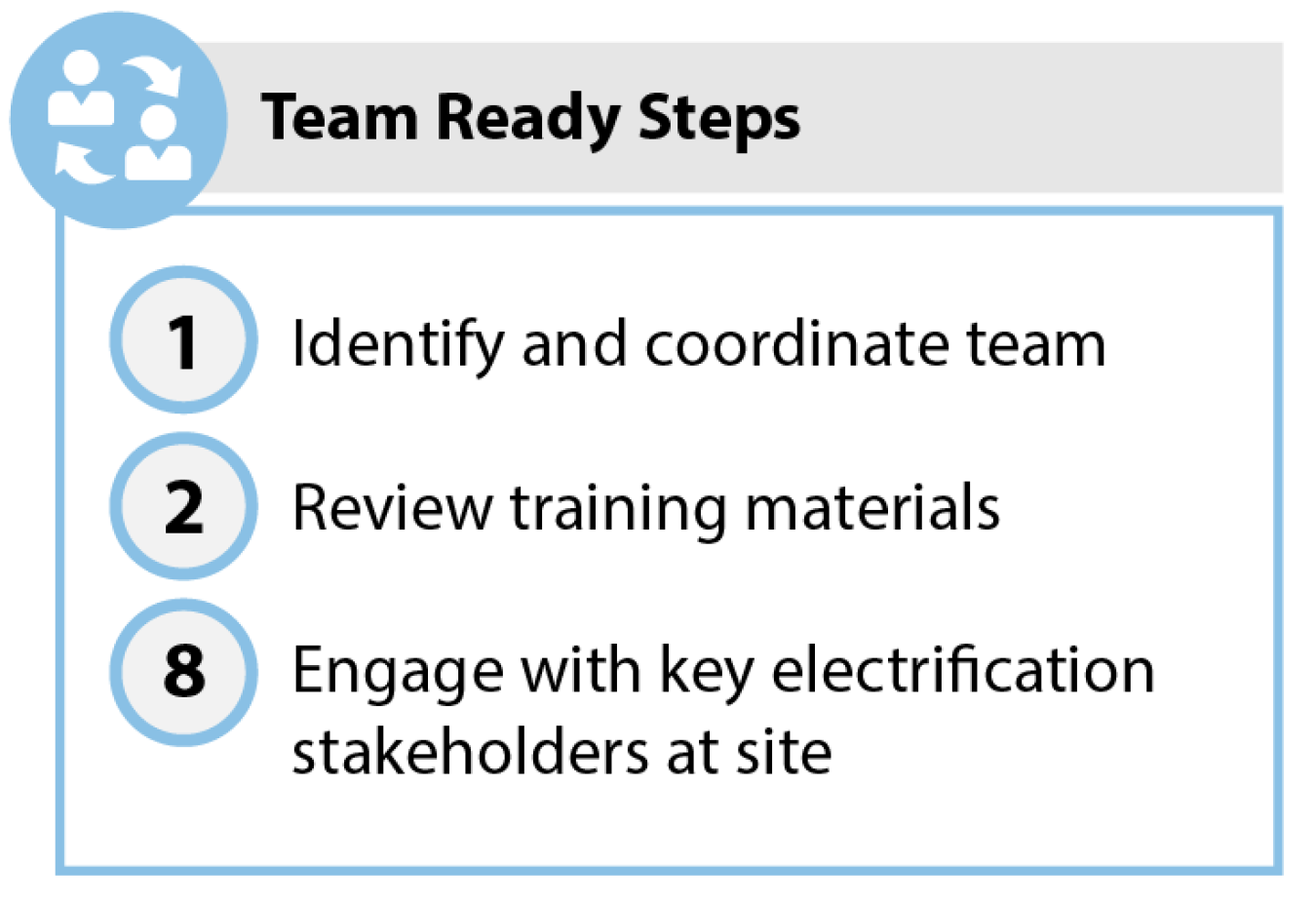
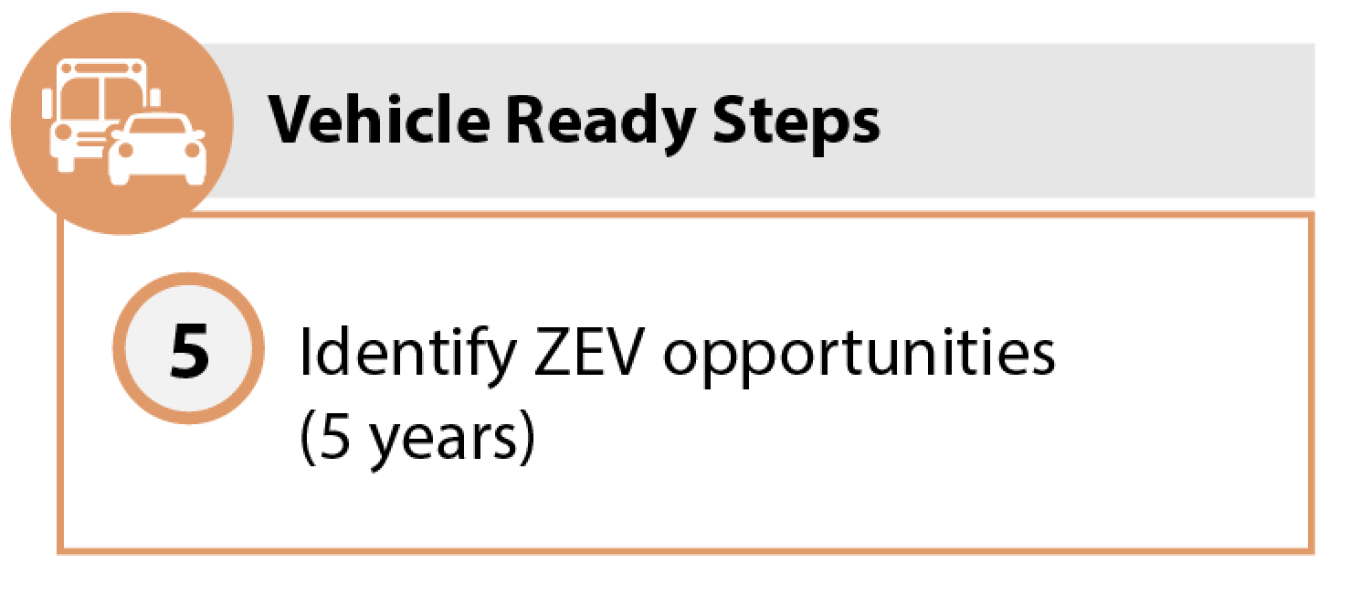
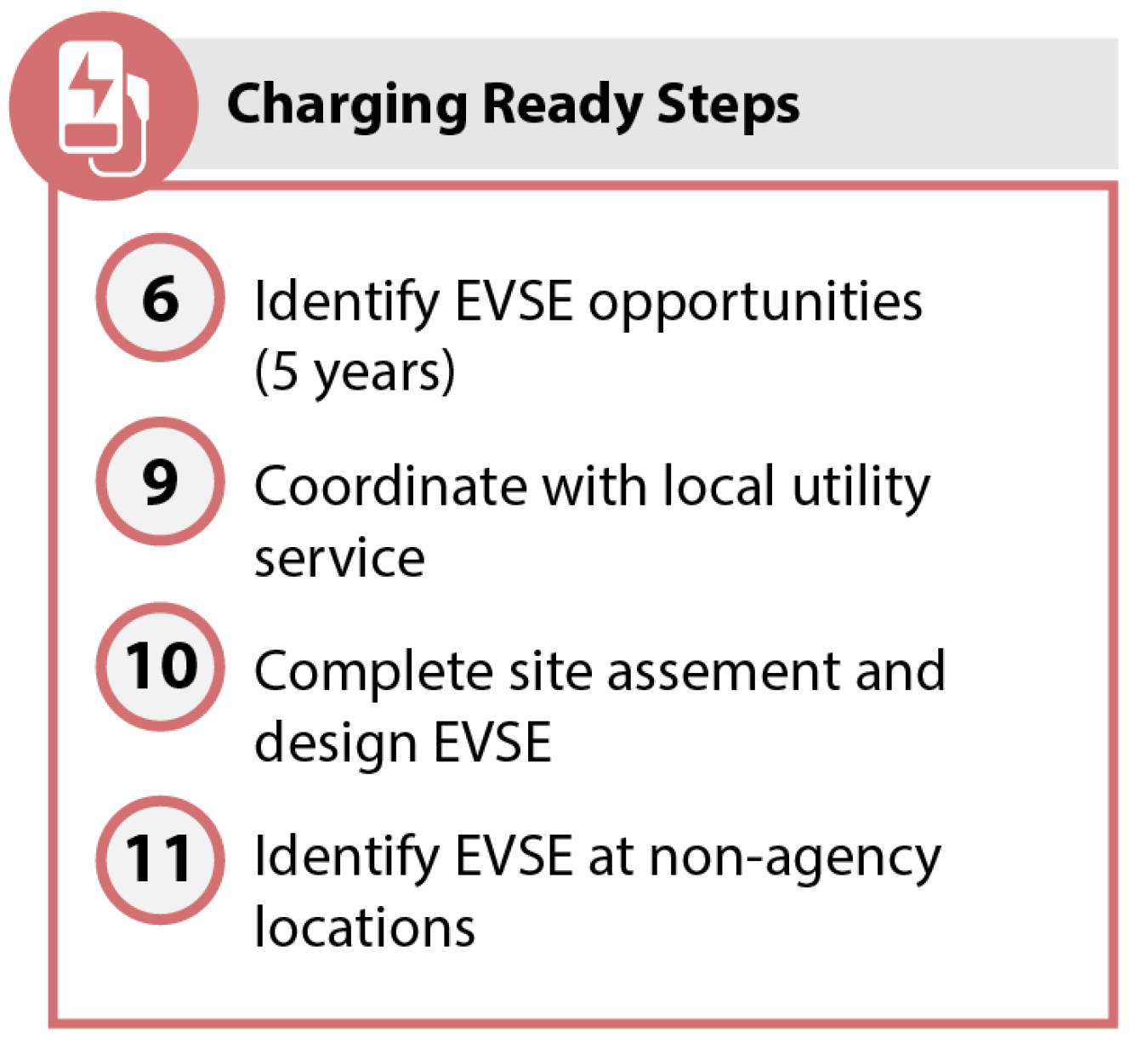
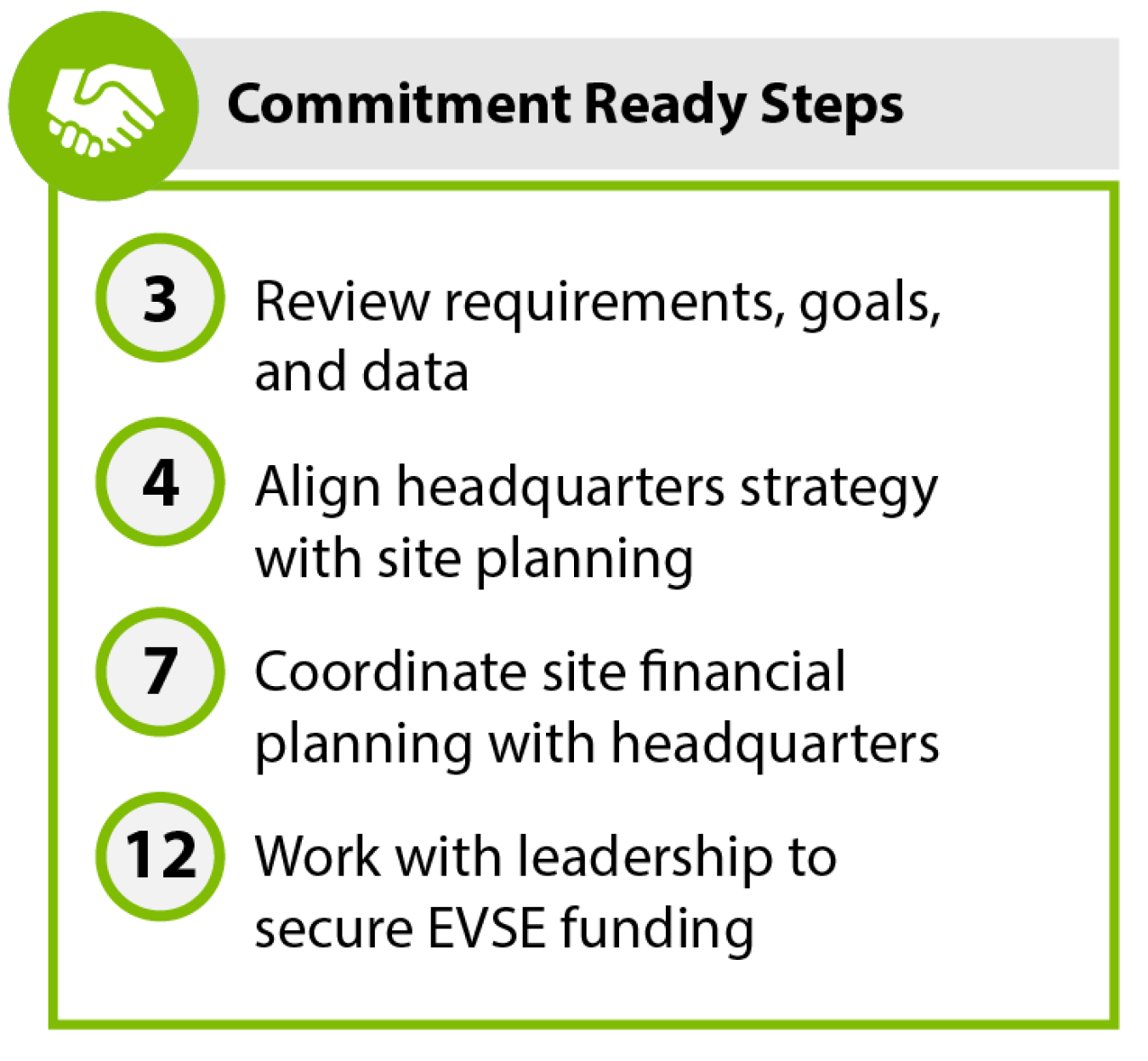
 Team Ready Designation
Team Ready Designation
The Team Ready designation includes three steps (Step 1, Step 2, and Step 8) that demonstrate the site has assembled and trained the team of key stakeholders and engaged and coordinated those stakeholders in the fleet electrification process. Once Steps 1, 2, and 8 are complete, the site is designated as Team Ready.
The key leader of the Team Ready planning area is the Site ZEV Champion.
Team Ready Key Leader

Site ZEV Champion
 Vehicle Ready Designation
Vehicle Ready Designation
The Vehicle Ready designation includes Step 5 and demonstrates the site fleet location has followed the actions to identify candidate vehicles for electrification. Once Step 5 is complete, the site is designated as Vehicle Ready.
The key leader of the Vehicle Ready planning area is the Site Fleet Manager.
Vehicle Ready key leader

Site Fleet Manager
 Charging Ready Designation
Charging Ready Designation
The Charging Ready designation includes four steps (Step 6, Step 9, Step 10, and Step 11) that demonstrate the fleet has followed the actions to determine EVSE needs at the site location and designed ZEV charging solutions specific to the site characteristics. Once Steps 6, 9, 10, and 11 are complete, the site is designated as Charging Ready.
The key leader of the Charging Ready planning area is the Site Facility Manager.
Charging Ready key leader

Site Facility Manager
 Commitment Ready Designation
Commitment Ready Designation
The Commitment Ready designation includes four steps (Step 3, Step 4, Step 7, and Step 12) that demonstrate the fleet has aligned and coordinated electrification efforts at the site location with overall agency leadership and goals. Once Step 3, 4, 7, and 12 are complete, the site is designated as Commitment Ready.
The key leaders of the Commitment Ready planning area are the Site ZEV Champion in coordination with the Agency Headquarters Fleet Electrification Manager.
Commitment Ready key leaders

Site ZEV Champion

Agency Headquarters Fleet Electrification Manager


